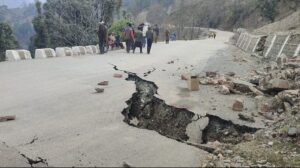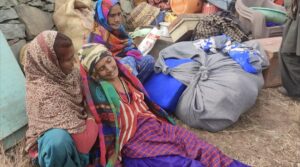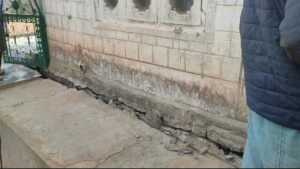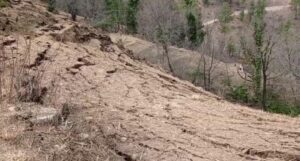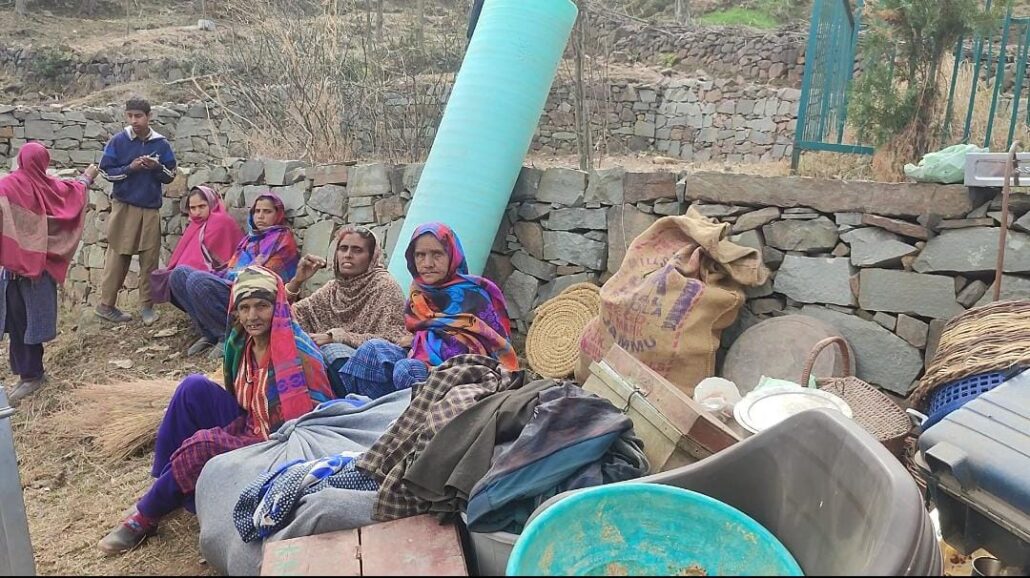
Sajad Chopan
Chaos is rising in the Daksar neighbourhood of Gool’s Dalwah area in Jammu Kashmir’s Ramban district, and villagers are moving their valuables and cattle in preparation for the worst, which they think is on the way. People have been forced to abandon their ancestral homes and farmlands.
Watch Video:
The panic spread around 2:30 AM on Friday (17 February 2023), when the locals felt the ground beneath them was slipping away. As the residents moved out of their houses, they witnessed the collapse of two residential houses and several others had developed cracks. An ancestral graveyard of the locality also sunk during the incident. “We could save only one dead body, the rest of the graves just slipped away during the subsidence incident,” locals told The Kashmiriyat.
Abdul Gani Pachoo, a local resident claimed that he was the first one to notice the sudden cracks developing in his house. “I felt that the earth was splitting apart and the whole area will drown. I could hear an enormous sound from underneath the ground which was terrifying. Somehow, I gathered courage to raise an alarm,” he said.
He said that the locals of the area gathered around his house and started rescue operations. “The young people helped in rescuing the old, children and women from the houses. They also shifted out the livestock and other valuables from the houses that were at high risk,” Abdul Gani recalled.
Two houses were damaged on day one, following which sixteen other houses developed cracks. “Now electricity transmission towers have developed cracks too. A part of the road from Gool to Sangaldan has collapsed too,” another local said.
The two houses that have been completely destroyed belonged to Farid Ahmed and Abdul Ghani Pachoo while the houses of Hanifa widow Muhammad Ashraf, Muhammad Sadiq son of Karim Din, Abdul Rashid son of Ali Mohammed, Mohammed Shafi, Muhammad Aslam Zargar, Shabir Ali, Habib Hijam, Abdul Rasheed Sheikh and others have been damaged, he said.
“There are big cracks in the ground. The houses are broken apart and the ground is still moving slowly and if it continues, many more residential houses may be affected,” Abdul Ganie said.
The Deputy Commissioner of Ramban meanwhile visited the area and said initially only four families were impacted who were shifted to a make-shift location, however, on Sunday further sinking was reported from the area. “As of now fifteen families have been migrated from the area to safer locations,” Mussarat Islam said.
He said that the administration is moving the people and their needs including warmth amid the cold season is being taken care of. “Teams of Geologists have been deputed the area to take a stock of the situation,” the DC Ramban said.
Officials said that as soon as they received the news of this incident, they immediately reached to the spot. “A massive area has been affected. Not only residential houses but agricultural land has also been damaged in the sinking,” an official told The Kashmiriyat.
The mountainous regions of Kashmir have reported sinking in the recent past. In Nayi basti area of Doda district, two houses sunk while nineteen others were partially damaged as sinking was reported in the area.
What is subsidence- Can it be dangerous?
The downward, vertical movement of the Earth’s surface, which can be brought on by both natural and human forces, is referred to as subsidence. Subsidence differs from slope movement in that it requires little to no horizontal movement.
Earlier, subsidence was caused by natural causes. However, in recent years, human activities like excessive mining and groundwater depletion have emerged as major contributors to the collapse of land surface. For example, groundwater flows that dissolve limestone to produce caves deep underground can also sculpt caverns that develop until their ceilings can no longer support overlying strata.
Because it can cause widespread property destruction, subsidence is a severe issue. Underground sewage, electrical, and water connections are broken, buildings develop cracks and collapse, and railway and roadways twist and break.
According to a study by Spanish academics, by the year 2040, ground subsidence will pose a hazard to over a fifth of the world’s population. In order to design measures to lower the danger of sinking, from local monitoring to cures, they developed a new model that evaluates local subsidence risks around the world.
